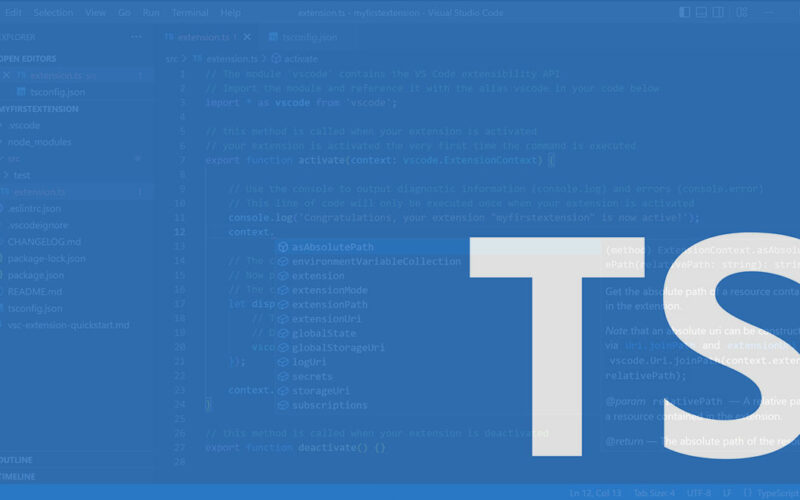TypeScript Today: What is TypeScript Used For?

Standing at the confluence of innovation and robust functionality, TypeScript emerges as the unsung hero of modern web development. Imagine scripting the architecture of digital masterpieces where each line of code aligns with precision—akin to an architect painstakingly drafting blueprints for future skyscrapers.
Here, in the realm of sprawling applications and intricate systems, TypeScript is not merely a tool but the craftsman’s refined chisel.
As the intricacies of web applications evolve, the quest for code scalability and type safety becomes paramount. TypeScript, the brainchild of Microsoft Corporation and shepherded into existence by Anders Hejlsberg, offers a sanctuary of structure in the often chaotic world of programming.
Venture through this article, and the shroud surrounding “what is TypeScript used for” will unravel, revealing the tapestry of its purpose woven intricately within the fabric of software development.
By journey’s end, readers will be versed in the TypeScript typing system, its role alongside JavaScript frameworks such as Angular and React, and the IDE support that streamlines the development process.
We’ll navigate together the dynamic landscape where TypeScript enhances JavaScript developers‘ craft, ensuring that every character typed is a step toward cross-platform development mastery.
What is TypeScript Used For?
TypeScript is used to develop large-scale JavaScript applications, offering type safety and enhanced development tools. It’s popular in frontend and backend development, enhancing JavaScript code with static types. TypeScript’s compatibility with JavaScript ecosystems makes it a preferred choice for improving code reliability and maintainability in complex projects.
| Use Case | Features | Frameworks/Libraries | Scalability | Key Projects |
|---|---|---|---|---|
| Web Frontend | Static typing for JavaScript | Angular, React, Vue | Modular codebase | Visual Studio Code |
| Web Backend | Node.js with strong typing | NestJS, Express | Load balancing | Deno |
| Full-stack Apps | Shared types across stack | MEAN/MERN with TypeScript | Consistent dev exp | Angular Universal |
| Enterprise Apps | Large codebase management | TypeORM, rxjs | Maintainable code | Office 365 web apps |
| Cross-platform | Use with JavaScript tools | Ionic, React Native | Reusable components | Slack’s desktop client |
Key Features of TypeScript

Static Typing
Ever wondered why web pages nowadays are so slick and error-free? A lot of that magic comes from static typing in TypeScript.
Think of it like having a grammar checker while you write. Except, instead of grammar, it’s your code. TypeScript checks your code as you type, making sure everything fits together perfectly.
Benefits of Optional Static Typing
Here’s the deal: In the world of coding, especially with JavaScript, things can get a bit wild. TypeScript brings in some much-needed order.
It lets you define what type of data your variables should hold. This means fewer surprises and bugs in your code. You know, the kind that makes you want to pull your hair out at 3 AM.
Comparison with Dynamic Typing in JavaScript
JavaScript is like that free spirit friend who’s spontaneous and fun but sometimes a bit unpredictable.
It uses dynamic typing, which is flexible but can lead to unexpected issues.
TypeScript, with its static typing, is like the friend who plans everything out. It might seem less exciting, but it sure does save you from some headaches.
Advanced Type System
TypeScript isn’t just about reducing errors; it’s about making your code as sharp and clear as a sunny day in California.
Interfaces, Enums, and Generics
Imagine you’re building a puzzle. TypeScript’s interfaces are like the edges; they give structure to your code.
Enums are helping you sort and organize. And generics? They’re like having puzzle pieces that can magically change size to fit wherever you need them.
Union, Intersection Types, and Access Modifiers
Ever seen a Swiss Army knife? That’s how versatile TypeScript is.
Union and intersection types let your variables be as flexible as a gymnast, holding more than one type of value.
Access modifiers are like VIP passes; they control who gets to access what in your code.
Enhanced IDE Support
Okay, but how does TypeScript make life easier for coders? It’s all about the tools and support.
Real-time Error Checking
Imagine having a friendly robot that points out mistakes as you make them.
That’s TypeScript in your IDE (Integrated Development Environment). It’s like having a coding buddy who whispers, “Hey, you might want to check that line again.”
Code Refactoring and Navigation Tools
Refactoring code in JavaScript can be like trying to rearrange furniture in a dark room.
TypeScript lights up the room. It makes moving stuff around safer and easier, ensuring you don’t knock over your precious code vase.
TypeScript in Web Development
Improved Code Quality and Maintainability
Ah, the never-ending quest for cleaner, more maintainable code. That’s where TypeScript steps in, like a superhero in the world of web development.
Early Error Detection
Picture this: You’re writing code, and boom, you make a typo. In plain old JavaScript, this might slip through until testing or, worse, production.
But with TypeScript? It’s like having a vigilant guardian. It catches these slips early. This means less time debugging and more time making cool stuff.
Readable and Maintainable Code Structure
Ever tried reading someone else’s code and felt like you’re deciphering ancient hieroglyphs?
TypeScript helps make code more like a well-written book. It’s clear, structured, and, most importantly, understandable.
This isn’t just good for you; it’s a blessing for anyone who’ll work on the code in the future.
Scalability and Large Projects
When it comes to big, complex projects, TypeScript is like the glue that holds everything together.
Suitability for Large Codebases
As projects grow, so does the complexity. More code, more features, more potential for chaos.
TypeScript introduces a level of discipline and structure that’s essential for scalability. It’s like having a good map when hiking in the wilderness.
You know where you’re going, and you stay on track.
Collaboration and Team Development
Working in a team? TypeScript is your friend. It’s like a common language that ensures everyone’s on the same page.
When you’re working with multiple developers, possibly across different time zones, clarity is key. TypeScript’s features like static typing and explicit interfaces make collaboration smoother, almost like a well-rehearsed orchestra.
In the realm of web development, what is TypeScript used for becomes a story of transformation.
It’s about turning the wild, sometimes unruly world of coding into a more organized, efficient, and collaborative environment.
For a closer look at the alternatives to this powerhouse, dive into this comprehensive guide on TypeScript alternatives.
TypeScript vs. Other Technologies
Let’s talk about how TypeScript stacks up against its peers. It’s like putting different superheroes side by side and seeing who brings what to the table.
Comparison with JavaScript

JavaScript and TypeScript are like siblings. Similar but with their unique quirks.
Superset Nature and Compatibility
TypeScript is like JavaScript’s cooler older sibling. It takes everything JavaScript has and adds its own flair, like static typing and advanced object-oriented features.
Imagine JavaScript as a basic phone, and TypeScript is the same phone but with a super high-tech camera.
Transitioning from JavaScript to TypeScript
For a JavaScript pro, moving to TypeScript is like switching from a manual to an automatic car.
There’s a bit of a learning curve, but once you get the hang of it, it’s smooth sailing.
TypeScript adds extra features that make coding more efficient and less prone to errors. It’s like having power steering and a GPS in your coding journey.
TypeScript and Other Languages
Now, let’s compare TypeScript to other players in the game.
Differences from Languages like CoffeeScript and Dart

Languages like CoffeeScript and Dart also try to enhance JavaScript, but they have their own paths. CoffeeScript is all about making JavaScript writing simpler.
Dart, on the other hand, is like an alternate universe to JavaScript. TypeScript, however, stays true to its JavaScript roots while enhancing it. It’s like upgrading your regular coffee to a gourmet espresso.
Positioning Among JavaScript Transpilers
In the land of JavaScript transpilers, TypeScript stands tall. It’s not just about making JavaScript look different; it’s about adding real, tangible value.
TypeScript ensures type safety and enhances the developer’s experience. It’s like being the star player in a team of superheroes.
When pondering what is TypeScript used for, it’s crucial to see how it compares and contrasts with other technologies.
Each has its strengths, but TypeScript shines with its compatibility with JavaScript and its additional features that make coding a more precise and enjoyable process.
For more insights, especially if you’re considering alternatives, this article on TypeScript alternatives offers a great comparison. It’s like getting a taste test of different coding flavors to see what suits your project best.
Practical Applications of TypeScript
Diving into the real world, let’s explore where TypeScript really shines. It’s not just theory; it’s about making things happen in the coding universe.
Use Cases in Modern Web Applications
TypeScript isn’t just a fancy tool; it’s the backbone of many modern web apps. Its superpowers come to life in various scenarios.
Single Page Applications (SPAs)
Think of your favorite web apps that load in a snap, like social media platforms or email clients.
Many of these are SPAs, and TypeScript is often the hero behind the scenes. It helps developers manage the complexity of these apps, keeping the code clean and understandable.
Enterprise-Level Applications
Large companies with massive web applications love TypeScript. Why? It brings order to chaos.
When you’re dealing with thousands of lines of code, TypeScript’s features like static typing and interfaces make it easier to keep track of everything. It’s like having a top-notch organizer for your digital closet.
Community and Ecosystem
TypeScript isn’t just about the code; it’s about the people and tools that make up its world.
Library and Framework Support
Imagine walking into a store where everything you need is within reach. That’s how TypeScript fits into the web development ecosystem.
Most major libraries and frameworks have TypeScript support, making it super easy to integrate into your projects.
Popularity and Community Contributions
TypeScript isn’t a lone wolf; it’s backed by a vibrant community. There are tons of resources, from tutorials to forums, where developers share their knowledge and experiences.
This community support makes learning and troubleshooting much simpler.
In the quest to understand what is TypeScript used for, these practical applications are key.
They show how TypeScript isn’t just a theoretical concept but a real, impactful tool in the web development toolkit.
For a deeper dive into what TypeScript brings to the table, especially in comparison to other options, this insightful piece on TypeScript alternatives is a great read.
It’s like having a guide through the landscape of programming languages, helping you make informed choices for your projects.
FAQ On What Is TypeScript Used For
Why is TypeScript gaining popularity in web development?
TypeScript is a rising star; think of it as JavaScript on steroids. It provides type safety, catching errors before they happen—akin to a spellchecker in a document. It’s no wonder that in complex projects, where predictability is crucial, TypeScript becomes a developer’s staunch ally.
How does TypeScript enhance JavaScript code?
Imagine JavaScript as dough. TypeScript kneads this dough adding static typing, resulting in a well-risen loaf with fewer surprises.
It’s about making the code more readable, maintainable, and easier to debug. In essence, TypeScript ensures the final code pastry is delicious and error-free.
Can TypeScript be used with frameworks like React or Angular?
Absolutely. TypeScript is like a Swiss Army knife for developers. It works hand-in-glove with frameworks like Angular and React, enhancing component-based architectures with its types.
This integration brings clarity to developers, leading to robust and scalable applications. It’s a match made in developer heaven.
What are the main advantages of using TypeScript in large projects?
In the world of large-scale applications, TypeScript is synonymous with organization. It facilitates code scalability and solidifies architecture, making it an asset for multi-developer environments. Plus, the integration with most IDEs bolsters productivity, making complex projects less daunting.
How does TypeScript improve code debugging and maintenance?
Imagine TypeScript as your coding sidekick. By enforcing types and highlighting errors during development, it turns debugging into a less hair-pulling experience.
It’s like having a meticulous proofreader for your code, ultimately easing long-term maintenance and making developers’ lives less stressful.
Is TypeScript compatible with all browsers and environments?
Here’s the scoop: TypeScript is like a universal translator. It compiles down to plain JavaScript, making the resulting code friendly for any browser or JavaScript environment. Whether it’s in a Node.js backend or a Chrome browser, TypeScript speaks their language.
Does TypeScript require a compilation step?
Compile-time error checking is where TypeScript shines. Yes, there’s an extra step—it needs to be compiled. But it’s a step worth taking. This process is like cross-referencing a map before starting a journey, ensuring that the path is clear and error-free.
How do TypeScript generics enhance coding?
TypeScript generics are like customizable molds. They allow developers to create reusable, type-safe components, ensuring that abstraction doesn’t come at the expense of precision. They’re essential for crafting versatile yet well-defined code structures that can adapt gracefully across use cases.
Does TypeScript support object-oriented programming concepts?
TypeScript not only supports but embraces object-oriented programming. It offers classes, interfaces, and inheritance, allowing developers to structure code with clarity and reuse.
This approach integrates seamlessly with the object-oriented paradigm, providing a familiar foundation with enhanced type safety.
How steep is the learning curve when transitioning from JavaScript to TypeScript?
The leap from JavaScript to TypeScript isn’t a cliff; it’s more like a small hop. If you’re already familiar with JS, you’ll find TypeScript’s additional features, such as static types and interfaces, to be a natural, empowering extension of what you already know.
Conclusion
Woven into the very fabric of modern digital craftsmanship, TypeScript’s purpose aligns with order, precision, and scale. At its core, it elevates JavaScript from dynamic fluidity into a structured entity, ready to construct monumental applications that stand the test of time and usage.
- Type safety and static typing form the cornerstone of this transformative scripting language, offering a rampart against the unforeseen bugs that often plague mammoth coding endeavors.
- Its chameleon-like ability to blend into various environments, be it React, Angular, or Node.js, showcases versatility beyond compare.
- Not just a language, TypeScript has become an artisan’s paradigm, representing a future where web development is synonymous with reliability and clarity.
In sum, the quest to understand what is TypeScript used for culminates in an epiphany of sorts; it’s a beacon of dependability in the oft-turbulent seas of code. Acknowledging its significance is embracing evolution—a gesture that fortifies the very backbone of scalable web architecture.
- Angular’s Applications: What is Angular Used For? - May 9, 2024
- Drive and Earn: Essential Apps Like Doordash - May 8, 2024
- The Benefits of Integrating Geofencing with CRM Systems - May 8, 2024








